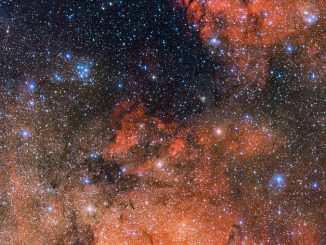M83, also known as the Southern Pinwheel Galaxy, is one of the largest and, at a distance of about 15 million light years, one of the nearest barred spirals to the Milky Way. The “grand design” galaxy has hosted multiple supernova blasts and appears to have a double core. Discovered in February 1752 by Nicolas-Louis de Lacaille, M83 was added to Charles Messier’s catalogue in 1781. The Hubble Space Telescope captured a spectacular view of M83 in 2014. A zoomed-in view shows countless stars in the galaxy’s outskirts embedded in rich clouds of gas and dust.





